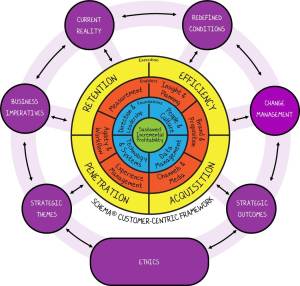Designing and executing a customer-centric business model requires end to end organisational alignment. Customer-centric capability development cannot take place in isolation to the rest of the business. The customer-centric journey requires a clear quantified understanding of current organisational capability across all 14 capability areas of the SCHEMA® Customer Management framework in the centre of the REAP Customer-Centric Blueprint below. As important as an understanding of current customer management capability is, so too is an understanding of the capability to which the organisation aspires.
Each week I’ll address another single capability area, sharing with you the Transformation Intent to which your organisation should commit to, as well as ‘What Good Looks Like’ for those organisations that have achieved a fairly high level of maturity in the respective capability area.
The REAP Customer-Centric Organisation Blueprint®
This week we are dealing with Efficiency which is one of the four Execution capability areas represented. The Execution layer relates to the capabilities and control levers needed to optimise customer value and include Retention, Efficiency (understanding cost to serve), Acquisition and Penetration (customer development, cross-sell and up-sell) – collectively referred to as REAP. These are capabilities and initiatives that can be optimised in the short term.
These capabilities support your ability to implement your chosen customer strategies and rely on the fundamental building blocks (Foundations) as well as the Enabling capabilities already discussed in Part 1 to 10 of this series of blog posts.
Each of the four Execution capability areas is made up of sub-components. The Efficiency dimension seeks to manage costs from a customer profitability perspective and evaluates costs in reference to the value of the customer for whom those costs are incurred. The 2 sub-components of the Efficiency dimension are ‘Calculating & Allocating Costs’ and ‘Controlling Costs.‘ Each of these areas is addressed in separate, individual blog posts.
Transformation Intent – Efficiency
“In treating different customers differently, your organisation needs to develop the capability to optimise customer profitability through the efficient calculation, allocation and control of customer costs in retaining, acquiring and developing your customers across all segments and channels. This enables you to perform value analysis in a way that supports your customer engagement within the defined profit bands per customer and per segment, and if need be, influencing their behaviour to reduce the cost-to-serve or even terminating them as customers if necessary.”
What Good Looks Like – Calculating & Allocating Costs
- Communication of dissatisfaction is encouraged from customers both directly and via staff. It is pro-actively drawn out by internal processes, even if there is no formal complaint.
- Complaints via regulatory bodies are dealt with enthusiastically and in a way that ensures their response standards are always met. Formal complaints received directly from customers are dealt with consistently across the organisation, to clearly defined standards which are themselves transparent to customers.
- Analysis of complaints extends to deep ‘root-cause’ levels and reporting is reviewed by very senior managers who are told the whole story.
- Issues likely to cause widespread dissatisfaction are dealt with quickly and incisively, using social and traditional media, making use of advocates and fans wherever possible.
- Relationship recovery is seen as an integral part of the dissatisfaction management process and is applied re-actively and/or pro-actively against a clear set of criteria of where it should be applied.
For more insight into customer-centric business model innovation as well as more insight into this particular area of the REAP Customer-Centric Blueprint, please see my book “The Customer-Centric Blueprint’ – http://amzn.to/ZILg4y





When it comes to customer engagement, this article is truly helpful. I am glad to come across the idea of cost to serve as discussed in this post. The concept about the REAP Customer-Centric Organisation Blueprint was truly well done.
Thank you. I noted that the copy relating to ‘what good looks like’ does not, in fact, relate to this specific section of the model. Please accept my apologies – the corrected copy is as follows:-
What Good Looks Like – Calculating & Allocating Costs
• The operating costs and even a sensible proportion of overheads that can be attributed to customer transactions and behaviours have been identified and either sourced from relevant finance systems or a meaningful estimation approach developed.
• These identified costs have been allocated to customers in a way that: allows them to be included in value analysis; recognises the difference between acquisition and service costs; enables match back to financial accounts.
• Responsibility for the level of cost represented by all customer groups and individual key customers has been allocated and all staff understand the importance of controlling customer-related costs.